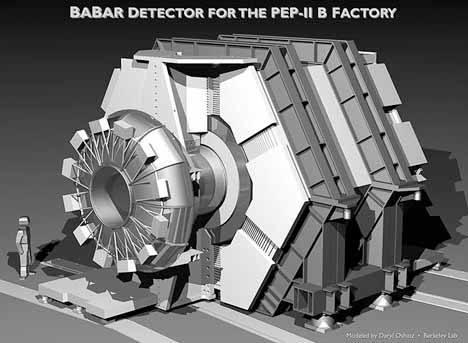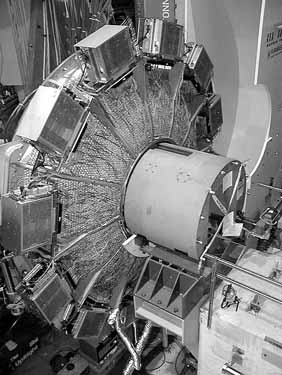 |
|
The Story of BABAR and the B's by Judy Jackson
"We've already written the paper; we just have to fill in the numbers," said collaborator David Hitlin, a physicist from the California Institute of Technology and BaBar's founding spokesman. "We know the statistical error." The "numbers" Hitlin and his collaborators will fill in for the worldwide gathering of B physics experimenters refer to the value of something called "sine two beta," a measure of the difference in the behavior of subatomic particles known as B mesons and their antimatter counterparts, "B bars," or anti-B mesons. The value of sin2b can vary from zero, indicating no difference in how B's and B-bars behave, to plus or minus 1, the maximum difference. The Standard Model, the theory that serves as the particle physicist's playbook, allows for a value somewhere between 0.5 and 0.9. Earlier results from BaBar and other experiments, including Fermilab's CDF, have not yet pinned down a value. Physicists everywhere will be listening eagerly for BaBar's latest results. They should be interesting. That's because BaBar is up to its collaborative ears in what scientists live for: data. Since the experiment began operating in January, 2000, particle collisions have poured into BaBar's detector at a rate beyond the experimenters' wildest dreams. Those billions upon billions of electron-positron collisions from SLAC's new B Factory accelerator mean that BaBar experimenters can close in on the key matter-antimatter difference they are seeking with an ever-diminishing margin of error. The more collisions, or integrated luminosity, the BaBar detector records, measured in units called "inverse femtobarns," the more accurate will be the determination of sin2b.
In fact, Smith explained, BaBar's wealth of data amounts almost to an embarrassment of riches. In contrast to the experience at many new particle accelerators, which often start slowly and gradually approach their design luminosity, the B Factory immediately began delivering particle collisions "like a firehose," in Smith's phrase. "This flood of data creates pressure on the experiment to deal with it all," Smith said. "The biggest stress is on off-line computing. We have much more data to deal with than we expected. We're a victim of our own success, which is a nice problem to have but is still a major challenge." BaBar appears to be up for the challenge. In something of a departure from earlier SLAC experiments, BaBar set out from its start in 1993 to create a thoroughly international collaboration. The 554 members of BaBar are evenly split, with 277 from U.S. institutions and 277 from abroad. Universities and laboratories from Canada, China, France, Germany, Italy, Norway, Russia and Taiwan make up exactly half of BaBar's 74 member institutions.
"This international aspect is absolutely crucial to the success of the experiment," Smith said. "The costs of building the detector were split about 60/40 between the U.S. and other countries, but we share the costs and responsibilities 50/50 when it comes to detector operation, data analysis, technical coordination and leadership of the collaboration."
International relations extend, in fact, beyond the collaboration itself to a "collegial" relationship with BaBar's main rival in the B physics enterprise, the Japanese experiment Belle, said Caltech's Hitlin. "There is a fair amount of contact between the BaBar and Belle collaborations," Hitlin said. "But the value of having two experiments is to have two independent measurements, so collegiality ends where the data begins. However, relations between the two experiments are very good."
Belle will also report results at the BCP4 conference. At a collaboration meeting at SLAC last month, BABAR seemed as busy as a highly successful beehive, and one on the edge of yet more success. True, the collaboration has a swarm of technical problems to solve. Bakelite panels in a detector component called the flux return have begun to deteriorate, for example; and computing needs have risen faster than budgets based on Moore's law of shrinking computing costs allowed for. BaBar collaborators must plan for dealing with still moreómuch, much moreódata in the near future, and for upgrading their detector for the long haul. But for the moment, at their December meeting, they were savoring the enviable and imminent prospect of announcing results that will significantly change the scientific understanding of the way the universe behaves. "It's a tremendous thrill to have come so far in so short a time," said SLAC Director Jonathan Dorfan. "February 2001 will usher in an exciting new era of discovery from the B factories." That's the buzz from BABAR and the B's. For more information on BABAR, B physics and the BCP4 conference:
|
| last modified 1/19/2001 email Fermilab |
FRLsDFx9eyfrPXgV
 Much of the buzz in particle physics these days comes from B's. More specifically, from B's and B-bars. That's because experiments studying these particlesóB mesons and their antimatter counterparts, anti-B mesonsóare on the verge of generating dramatic new insights into the enigmatic asymmetry between matter and antimatter. The buzz will reach a crescendo when the Stanford Linear Accelerator Center's BABAR collaboration announces major new results at physics conferences next month.
Much of the buzz in particle physics these days comes from B's. More specifically, from B's and B-bars. That's because experiments studying these particlesóB mesons and their antimatter counterparts, anti-B mesonsóare on the verge of generating dramatic new insights into the enigmatic asymmetry between matter and antimatter. The buzz will reach a crescendo when the Stanford Linear Accelerator Center's BABAR collaboration announces major new results at physics conferences next month.
 "BaBar has recorded 23 inverse femtobarns of integrated luminosity," said BaBar spokesman Stew Smith of Princeton University. "The results announced in February will be based on 20 inverse femtobarns in the upsilon 4S resonance, [the principal pattern of B meson behavior observed by the experiment] as well as another 15 percent of off-resonance data."
"BaBar has recorded 23 inverse femtobarns of integrated luminosity," said BaBar spokesman Stew Smith of Princeton University. "The results announced in February will be based on 20 inverse femtobarns in the upsilon 4S resonance, [the principal pattern of B meson behavior observed by the experiment] as well as another 15 percent of off-resonance data."
 Belle has so far recorded about 11 inverse femtobarns of luminosity to BaBar's 23, but "Belle is breathing down our neck," Smith said. "In their best week, they recorded 800 inverse picobarns. BaBar's best week was 970."
Belle has so far recorded about 11 inverse femtobarns of luminosity to BaBar's 23, but "Belle is breathing down our neck," Smith said. "In their best week, they recorded 800 inverse picobarns. BaBar's best week was 970."